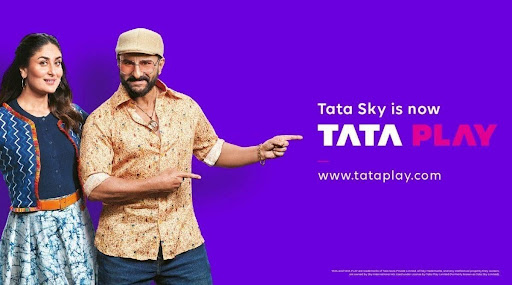Everything to Know About The DTH Technology And The Way Ahead
Do you remember how the TV used to look in your home in the early days? There were blurry pictures on the screen that you had to keep adjusting with a knob only to get an unclear and hazy view. If it seems like a distant memory or something that you have never even seen, it’s probably because the viewing technology has undergone a sea change in the last ten years.
The role of cable operators has been waning out gradually, and it’s the era of DTH technology from the top names in the business, such as Tata Sky, India’s biggest DTH service provider which recently rebranded to Tata Play. With this new name and identity, Tata Play provides traditional DTH services and popular OTT platforms under one platform. It’s the era of engaging content, better picture quality, improved sound, and an enhanced TV-viewing experience. Read more about this advancement here!
What exactly is DTH technology?
Direct to Home or DTH technology offers digital satellite services that provide television channels directly to your home through a personal dish antenna. High-definition TV (HDTV) and 3D TV are the additional features of the technology. Additionally, there are options to record, rewind, and pause live TV from your HD set-top box. The #MakeInIndia set top boxes manufactured by Tata Play offer better sound and picture quality along with other benefits.
Advantages of Direct-to-Home technology by Tata Play
Whether you use an HD or android set-top box by Tata Play, the advantages you get are one too many. Outlined below are some of the prime benefits of subscribing to Tata Play:
- No charges for service visits
- A higher number of channels
- Multiple language options
- Payment is needed only for the services and channels the user wants
- Tata Play Binge Combo for OTT platforms and regular channels
- Easy recharge and manage packs via the Tata Play mobile app or website
- No reconnection charges for de-active customers
To elaborate further on this last point, Tata Play has come up with this amazing offer of Tata Play Binge combo that lets you enjoy the popular OTT platforms (Netflix, Disney+Hotstar, Zee5, VOOT, and more) and the regular TV channels under one affordable plan. You will not have to juggle between different subscription plans, simplifying and enhancing your viewing experience.
Let’s look at some of the components and technicalities of Direct-to-Home technology
Dish Antenna
A dish antenna is basically a parabolic reflector. It gets the signals and sends them to the Low Noise Block Down Converter plus Feedhorn that functions as a receiver for the signals sent out by satellite parabolic reflector.
Low Noise Block Down Converter Feedhorn (LNBF)
A feedhorn is the small metal horn antenna present on the dish. Its function is to collect the signals from the dish and amplify the signals bouncing off that dish. Finally, it filters out all the noise, the signals not carrying any program.
Coaxial Cable
It is a cable whose work is to connect the mini-dish and the set-top box.
Set-Top Box
Unlike what you find in the case of any standard cable connection, the set-top box decodes that encrypted transmission data. It gets the signals converted into video and audio signals.
The architecture of DTH new connection
Satellite
A geostationary satellite has an important role in any DTH system. These satellites have a wider range of the line of sight because they remain higher in the sky compared to basic TV antennas. It gets the signals to reach the DTH antenna. In Oct 2021, ISRO’s commercial arm, NewSpace India Limited (NSIL) announced the launch of a four-tonne communication satellite GSAT-24 whose entire satellite capacity will be leased to Tata Play. This will further enhance Tata Play’s DTH services encompassing the entire geographical boundary of India with better quality signal strength.
Broadcasting Centre
Think of the broadcasting center as the core of the DTH connection. The television provider gets signals from different programming sources and beams one broadcast signal to the satellites that remain in the geostationary orbit. These satellites get the signal from the broadcast station to have them re-broadcasted to the ground.
Multiplexer
A multiplexer is a crucial device that is used for transmitting the information of multiple channels in a single channel. It’s essentially a part of the broadcast center. The multiplexer compresses the frequency signals in a single channel in the broadcasting center. Finally, it gets transmitted to that geostationary satellite. The modulator receives the single channel from the multiplexer.
Modulator
Modulation refers to a process through which the information signal gets imposed on the carrier signal that has a higher strength. The signals are modulated at this stage and then the encoder receives them.
Encoder
At this stage, the encoder has to encode the signals for transmitting the signals. So, the satellite delivers the signals to the antenna, which further helps them reach the set-top box to complete the chain.
DTH Receiver
The final (and extremely important) component of the complete DTH system is the receiver. The encrypted signal is descrambled or decoded at this stage. In the case of the unlocking signal, it requires the correct decoder chip for the programming package. Now, the service provider may communicate using that chip using satellite signals to make the necessary operations to the decoding program.
How does a dish connection through the DTH technology works?
One of the most interesting parts of the DTH technology is how all the components come together to form the architecture that enhances your TV viewing experience.
The satellites that are present almost 35,700 km over the earth surface sends signals to the broadcasting stations present on the earth surface. The broadcasting center gets the signals and the transponder on the satellite aids in establishing a communication channel between the receiving and transmitting units. Then, the satellite starts rebroadcasting the encoded signals.
The encoder converts the data, video, and audio signals in the digital format. Then, the multiplexer comes into the picture to combine or mix the signals. Finally, there is a set-top box and a small dish antenna present at the user’s end to view, decode, and receive different channels.
The endnote
So, you have had the DTH connection in your home for such a long time. Yet, you never knew anything about all that goes behind the scenes to give you that great picture quality and sound. And now you do!
While so much goes on at the backend, trusted and reliable DTH service providers, such as Tata Play, ensure the customers get all the benefits of the technology with comprehensive services and affordable packages. With this rebranding move, Tata Play delivers a hybrid television viewing experience to millions of Indian customers.


















